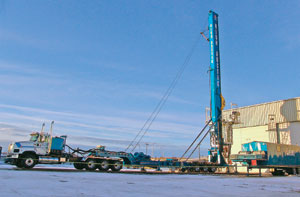 |
Norway |
|
Underbalanced drilling and workover rig takes to the road
Jens Petter Røkenes, EDM, Stavanger
EDM’s patented rack-and-pinion (R&P) rig with a push-and-pull capability has moved into Canada, in a mobile, onshore version. Previous stationary versions of the design were operated successfully offshore Norway and the UK, and onshore in Los Angeles, California. EDM and Canadian firm, High Arctic Energy Services, have joined forces and developed this advanced, trailer-mounted unit for underbalanced drilling and workover services.
Canadian E&P projects are very demanding and require rugged equipment. Oil and gas production in Alberta is prolific but widely spread. This requires fast-moving units that can operate in harsh environments. Today, there are about 640 drilling rigs and 65 snubbing units, plus about 900 well service rigs operating in Western Canada, alone. This market is very demanding, and the requirement for new, safer equipment is high.
High Arctic, the largest underbalanced service provider in Canada, approached EDM about 18 months ago and, through a pre-engineering phase, found that the EDM rig design would provide the base design to improve the type of snubbing operations that High Arctic typically deals with. The Canadian company has, over the years, gained the necessary field experience to know what is required to improve these operations and committed $5 million to the research, design and development of the new Hybrid Rig.
 |
The 250K Hydraulic Underbalanced Workover rig is highly mobile, and can be set up and taken down quickly.
|
|
EDM’s technical knowledge, combined with High Arctic’s experience, produced the 250K Hydraulic Underbalanced Workover Rig. The highly mobile unit is mounted on a trailer and driven hydraulically from a drop box on the truck. This rig can perform work with or without pressure in the well.
The R&P technology has been improved, based on the specifications from High Arctic, from earlier models for better performance and reduced weight. The weight reductions have made it possible to transport the 23-m-long (75.5-ft) rig – including three utility winches, a sand line winch, workbasket, rotary table and BOPs – as one unit, road-legally throughout Canada. This makes rig moves quick and easy, without the need for special road permits.
The rig can handle range III (45-t) pipe, with both normal and snubbing BOPs installed. The stroke is from 46 to 62 ft, depending on the BOP height. The unit is based upon the patented R&P hoist system with hydraulic motors. The hydraulic system is high-pressure for maximum effect and lowest weight, with less fluid to move.
The hoisting system is controlled by a PLC, with an integrated floor and “crown” saver, and it is flexible enough to accommodate any workbasket height. The operator can also set the lifting height to an automatic stop, in line with the pipe length being run. Usable BOP space is flexible, from 2 to 10 m (6.6 to 32.8 ft).
| |
250K rig – Main technical data: |
|
| |
Lifting capacity: |
250,000 lb |
|
| |
Push capacity: |
125,000 lb |
|
| |
Lifting height: |
min. 46 ft |
|
| |
Rotary torque: |
12,000 ft-lb |
|
| |
Rotary speed: |
100 rpm |
|
| |
Weight: |
56 tons, including
rig, trailer, truck
and BOPs |
|
|
On the top floor, the control panel is installed, together with pipe fingers for racking pipe on the ground. An automatic pipe chute (cat walk machine) is attached to the workbasket, to pick up or lay down tubulars. The pipe chute is radio-controlled in the same way as all winches.
The rotary table is installed in the dolly with electronic weight sensors for accurate measurement of the lift and push forces. Overall, the rig is easily operated with a joystick. 
|




